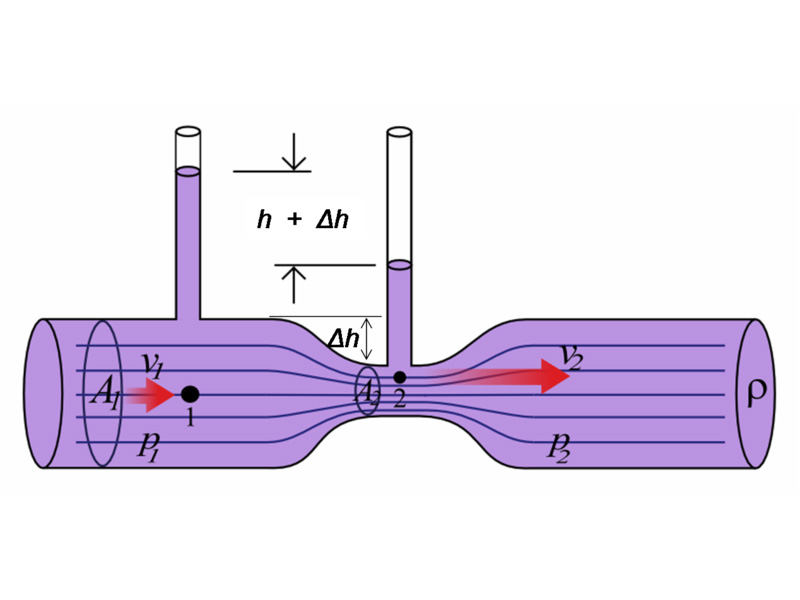Fluid mechanics describes the basic intrinsic properties and mechanical behaviors of fluids. Comprising both liquids and gases, fluids do not have a definite shape but take the shape of their container.
In one sense, Fluid Mechanics is not as 'fundamental' as the primary topics of mechanics, such as Newton's Laws or Work & Energy, which are underpinnings of all of science. Nevertheless, Fluid Mechanics is the equal of any topic in the physical sciences as a straightforward source of MCAT questions. The major topics of Fluid Mechanics are enduring MCAT favorites, such as Archimedes Principle, the Continuity of Volume Flux, or Bernouli's Law. Nearly every MCAT has several questions from Fluid Mechanics.
WikiPremed Resources
Fluid Mechanics Cards
Conceptual Vocabulary Self-Test
Basic Terms Crossword Puzzle
Basic Puzzle Solution
Conceptual Vocabulary for Fluid Mechanics
Fluid Mechanics
Pressure is the force per unit area applied on a surface in a direction perpendicular to that surface.
A fluid is defined as a substance that continually deforms under an applied shear stress regardless of the magnitude of the applied stress.
Bernoulli's Principle states that for an ideal fluid with no work being performed on the fluid, an increase in velocity occurs simultaneously with decrease in pressure or a change in the fluid's gravitational potential energy.
Density is mass per unit volume.
The pascal is the SI unit of pressure or stress.
Buoyancy is the upward force on an object produced by the surrounding fluid in which it is fully or partially immersed.
A liquid is a fluid that can freely form a distinct surface at the boundaries of its bulk material.
Viscosity is a measure of the resistance of a fluid to deform under shear stress.
Pascal's law states that for all points at the same absolute height in a connected body of an incompressible fluid at rest, the fluid pressure is the same, even if additional pressure is applied on the fluid at some place.
Fluid dynamics is the sub-discipline of fluid mechanics dealing with fluids in motion.
Hydrodynamics is fluid dynamics applied to liquids.
The volumetric flow rate, also volume flow rate, is the volume of fluid which passes through a given surface per unit time.
Turbulent flow is a flow regime characterized by chaotic, stochastic property changes such as low momentum diffusion, high momentum convection, and rapid variation of pressure and velocity in space and time.
Laminar or streamline flow occurs when a fluid flows in parallel layers, with no disruption between the layers.
Surface tension is an effect within the surface layer of a liquid that causes that layer to behave as an elastic sheet.
Capillary action is the ability of a substance to draw another substance into it such as with water and porous paper.
Meniscus is a curve in the surface of a liquid produced in response to the surface of its container.
Identifying different flow regimes, such as laminar or turbulent flow, the Reynolds number is the ratio of inertial forces to viscous forces quantitfying the relative importance of these two types of forces for given flow conditions.
An incompressible flow is flow in which the divergence of velocity is zero. This is more precisely termed isochoric flow.
A flow is considered a compressible flow if the change in density of the flow with respect to pressure is non-zero.
For a viscous liquid flowing through a cylindrical tube with constant circular cross-section, Poiseuille's law relates the flow rate, pipe radius, pipe length, and the pressure difference between the two ends.
Fluid statics is the science of fluids at rest, and is a sub-field within fluid mechanics.
A non-Newtonian fluid is a fluid in which the viscosity changes with the applied strain rate. As a result, non-Newtonian fluids may not have a well-defined viscosity.
A Newtonian fluid is a fluid that flows like water-its stress versus rate of strain curve is linear and passes through the origin. The constant of proportionality is known as the viscosity.
The no-slip condition states that at a boundary, fluids have zero velocity relative to the boundary.
A boundary layer is that layer of fluid in the immediate vicinity of a bounding surface.
Wetting is the contact between a liquid and a surface.
The Navier-Stokes equations establish that changes in momentum in infinitesimal volumes of fluid are simply the sum of dissipative viscous forces, changes in pressure, gravity, and other forces acting inside the fluid.
Vorticity is a mathematical concept used in fluid dynamics which is related to the amount of circulation or rotation in a fluid.




